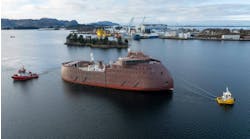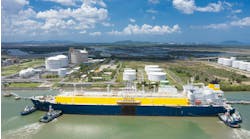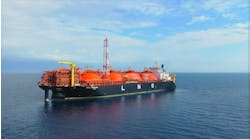Seabulk orders newbuilds for West Africa, Brazil
Jaime Kammerzell
Gulf of Mexico Editor
Seabulk International has been building newer, bigger supply vessels for the international market over the last two years. The Seabulk fleet, like most fleets, is growing older, while the international supply vessel market is growing stronger. Though the Gulf of Mexico has been in a slump for the past two years, it is showing signs of renewal, which is encouraging. However, the focus for Seabulk is the international market, specifically West Africa and Brazil, as well as Southeast Asia and Mexico.
The industry fleet has been undergoing a renewal for the past five years, and this will continue with the demand for newer tonnage. The new vessels are more sophisticated, economical, and environmentally protective. They boast such features as DP and well-stimulation equipment that makes recovery more efficient and more productive. In fact, in certain instances, one new boat can do the work of two older generation vessels.
(Above) The Seabulk Africa is a 236-ft DP PSV operating off West Africa. (Below) The Seabulk South Atlantic is a 222-ft AHTS working off West Africa.
Seabulk's fleet renewal program is well underway with the delivery or construction of 10 new vessels since the beginning of 2003. "We currently have about 114 vessels, and over the next five years, it is likely that we will get down to around 75 high-volume, high-margin vessels," Jack O'Connell, senior vice president of investor relations, Seabulk International, says. "As the older vessels are retired, scrapped, or sold, we replace them with new, sophisticated tonnage. For every one-and-a-half or two older vessels, we bring in one new vessel. So we'll have fewer vessels, but they'll be bigger, more profitable, and more economical to operate, and we expect that they'll generate higher earnings."
For the West African market where most of the new discoveries are in deepwater, Seabulk is building anchor handling tug supply vessels (AHTSs) with 8,000-12,000 hp. In Southeast Asia, its focus is on slightly smaller AHTSs with 6,000-8,000 hp.
"We don't want to get into very high end or very low end vessels," O'Connell says. "We want to build a fairly standardized unit that can be used virtually anywhere in the world."
Under construction
Responding to the growing worldwide demand for West African oil, Seabulk International has ordered two additional vessels for its West African fleet, which currently numbers 40. The Seabulk Advantage and the Seabulk Luanda bring to five the number of newbuilds under construction. Of the five, three are destined for West Africa and two for Brazil.
The Seabulk Advantage is a 4,800-hp, four-point-mooring platform supply vessel (PSV) being built in China by Jaya Shipbuilding & Marine Pte. of Singapore. The $8.6-million PSV will be delivered late this year. Singapore-based Labroy Marine Ltd. is building the Seabulk Luanda, a $14.8-million, 8,000-hp AHTS. The AHTS will be delivered in mid-2005. Labroy Marine is also constructing the $10.8-million Seabulk Angola, an 8,000-hp, AHT scheduled for delivery in early 2005. All three vessels will work under long-term contracts for a major international oil company offshore Angola.
Hot spots
West Africa has become one of the hottest drilling plays in the world with more than $40 billion in estimated exploration and production spending planned over the next five years, according to oil company projections. It has also become an important source of crude for the US, which is seeking to reduce its dependence on Mideast oil.
Nigeria currently is the largest producer, with close to 3 MMb/d. Nigeria produces a light, sweet crude, which is much in demand, particularly in the US and Europe. Seabulk has more than 20 vessels operating in Nigeria – the most of any US company – and also has a joint venture, Modant Seabulk Nigeria, with a local company. Other large offshore producing countries include Angola, Equatorial Guinea, Congo, and Cameroon. Angola, having finally settled its longstanding civil war, is fast emerging as the next Nigeria, with large planned investments and significant discoveries, O'Connell says.
Seabulk is also focusing on Brazil, which is ramping up production in an effort to become energy self-sufficient. Petrobras has an aggressive deepwater exploration and development program, which is largely limited to Brazilian flag vessels. Seabulk is building two 5,500-hp, UT-755L PSVs in Brazil at the Promar shipyard for the Brazilian market. Of those two vessels, one will come online this month and the other in February 2005. O'Connell says they will likely work for Petrobras. "This is a market that in many ways resembles West Africa," O'Connell says, "where there is vast potential for undiscovered reserves."
Seabulk's offshore fleet operates in more than 25 countries. Half of the company's offshore revenues derive from West Africa, about 25% comes from the Gulf of Mexico and Caribbean, and the remainder is divided between the Middle East and Southeast Asia.
"The offshore industry worldwide is very active," O'Connell says. "Most new discoveries are offshore, so the outlook as a whole looks very bright. With commodity prices where they are now and world energy demand forecast to grow pretty steadily, and no viable alternatives to oil and gas in the foreseeable future, the supply vessel industry is a great place to be."





